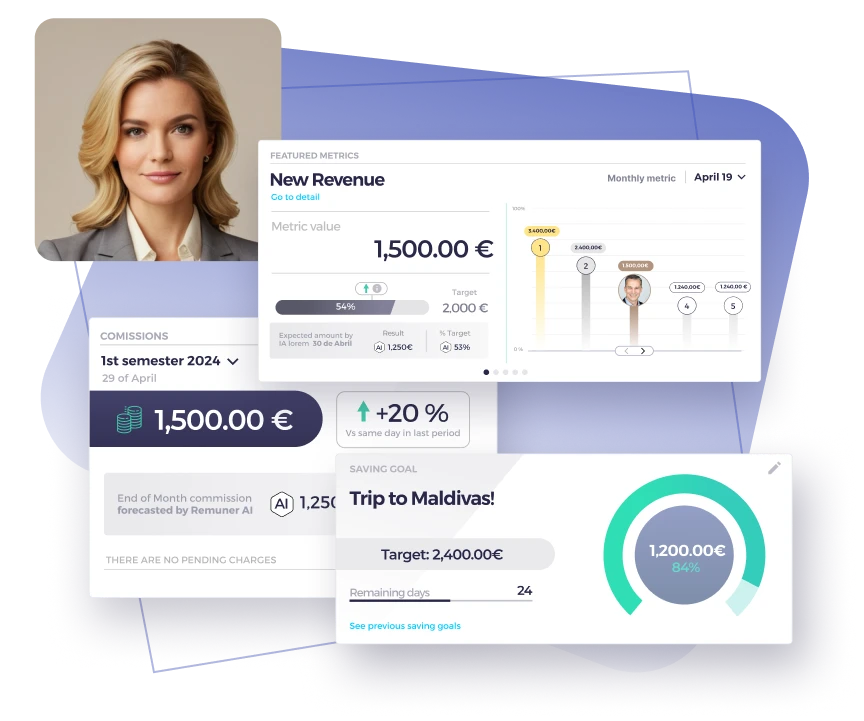Table of contents
What is a Spiff?
A spiff is a targeted, short-term incentive designed to motivate sales representatives to achieve specific objectives quickly. Unlike regular commissions or bonuses, which are tied to long-term performance or overall sales goals, a spiff is a temporary reward—usually monetary—that encourages immediate action.
This can range from cash bonuses to non-monetary rewards like gift cards, vacations, or even special recognition within the company. The goal of a spiff is to drive quick wins and boost sales performance in a short period, making it an incredibly versatile tool for sales managers.
The power of spiffs in sales incentives
Using spiffs effectively can lead to significant improvements in sales outcomes. Here’s why it is so impactful:
1. Immediate impact on sales performance
A spiff is designed to have an immediate effect. By focusing on short-term goals, such as pushing a specific product or achieving a monthly sales target, a spiff can quickly energize a sales team. This immediacy can translate into quick boosts in sales performance, helping companies meet urgent sales objectives.
2. Customization and flexibility
One of the main advantages of a spiff is its flexibility. You can tailor it to fit any sales scenario, from increasing the sales of a particular product to encouraging the adoption of a new sales strategy. This customization allows companies to target specific behaviors or outcomes, making spiff a precise tool in the broader sales incentive arsenal.
3. Enhances competition and engagement
Spiff programs often introduce a gamified element among sales teams. When rewards are clearly defined and achievable, sales representatives are more likely to engage in friendly competition, pushing each other to perform better. This gamification of sales can significantly enhance sales performance, as team members strive to outdo each other.
Examples of Spiffs in action
1. Product lunch push
A software company is launching a new product and wants to ensure it gains traction quickly. To incentivize the sales team, the company introduces a spiff program where any salesperson who sells at least 10 units of the new product within the first two weeks of launch receives a $500 bonus. This spiff motivates the sales team to focus their efforts on the new product, resulting in a successful launch with significant early sales.
2. End-of-Period sales boost
At the end of a challenging period, a retail company needs to meet its sales targets. To give the final push, they implement a spiff that offers an additional 2% commission on all sales made in the last two weeks of the period. This incentive encourages sales reps to go the extra mile, closing more deals and pushing the company past its quota.
3. Clearing old inventory
An electronics retailer needs to clear out older models to make room for new inventory. The company offers a spiff where any salesperson who sells 20 units of the old model within a month will receive a $300 gift card. The sales team, motivated by the extra reward, focuses on promoting the older models, leading to a successful inventory clearance.
4. Encouraging cross-selling
A financial services firm wants to encourage its advisors to cross-sell additional products to existing clients. They introduce a spiff where any advisor who successfully sells a bundled package of services within the next month receives a $200 bonus. This spiff not only boosts the number of cross-sales but also increases the overall value of each client relationship, enhancing sales performance and customer satisfaction.
Integrating Spiff into your sales compensation plan
To make the most of a spiff program, it’s essential to integrate it seamlessly into your overall sales compensation strategy. Here are some tips:
1. Align Spiff with OTE and Quota
Ensure that your spiff complements the existing compensation structure, including On-Target Earnings (OTE) and sales quotas. A spiff should motivate sales reps to exceed their usual targets without detracting from their long-term goals. This balance is key to maintaining sustained sales performance.
2. Use data to design effective Spiff programs
Data-driven decision-making is crucial when designing a spiff. Analyze past performance data to identify areas where a spiff could have the most impact. For example, if certain products or services are underperforming, a spiff could be used to boost their sales. By aligning the spiff with data insights, you ensure that the program is both strategic and effective.
3. Clear communication of spiffs is key
Transparency is vital when rolling out a spiff. Sales teams need to understand exactly what is required to earn the reward, how long the spiff will last, and what the reward will be. Clear communication ensures that everyone is aligned and focused on the same goals, maximizing the effectiveness of the spiff.

Avoiding potential pitfalls when implementing Spiffs
While spiff incentives can be incredibly effective in driving short-term sales performance, there are potential issues that companies should be aware of to ensure their spiff programs are successful and sustainable. Here are some common challenges and recommendations on how to avoid them:
1. Offer valuable and desired rewards
Potential Issue: One common mistake is offering generic or low-value rewards, such as a pizza party or a gift basket, which may not create enough excitement to motivate your sales team.
Solution: Incentives should be something your salespeople truly value. Take the time to understand what motivates your team by conducting surveys or asking for feedback during performance reviews. Involving your sales reps in the reward selection process can also create a stronger connection to the spiff program, as it shows that their input is valued and that you’re investing in what matters most to them.
Tip: Consider using tools that allow for anonymous feedback to get honest insights into what drives your team. This approach ensures that the rewards are both motivating and relevant.
2. Ensure fairness to avoid favoritism
Potential Issue: If a spiff only benefits top performers, it can breed resentment among other team members and create a toxic work environment, ultimately disrupting productivity.
Solution: Structure your spiff programs in a way that gives all eligible participants an equal chance to succeed. Goals should be attainable and not disproportionately favor certain sellers’ abilities or existing networks. This approach promotes a more inclusive and motivating environment.
Tip: Use transparent tracking tools that allow all team members to see spiff progress. This transparency not only builds trust but also ensures everyone feels they have a fair shot at achieving the rewards.
3. Set achievable goals
Potential Issue: Setting goals that are either too high or too low can demotivate your sales team. If goals are too high, they may seem unattainable, while goals that are too low might not generate enough interest or effort.
Solution: Choose goals that are challenging yet realistic. Analyze historical sales data, consider market conditions, and account for your sales reps’ capacities to set appropriate targets. Establishing clear milestones and a realistic timeframe can also help maintain motivation throughout the spiff period.
Tip: Regularly review and adjust goals based on performance data and feedback from your team. This iterative approach ensures that goals remain relevant and motivating.
4. Avoid sandbagging by timing Spiffs wisely
Potential Issue: Sales reps might hold off on closing deals if they know a spiff is coming, waiting until the program starts to maximize their rewards. This behavior, known as sandbagging, can disrupt sales cycles and hurt overall performance.
Solution: To prevent sandbagging, consider keeping spiff programs a surprise. By not announcing spiffs in advance, you can encourage consistent effort and prevent reps from gaming the system.
Tip: If you must announce spiffs ahead of time, consider structuring them in a way that rewards ongoing effort rather than just focusing on the final outcome.
5. Manage your budget and frequency of Spiffs
Potential Issue: Overusing spiffs can lead to budget overruns and diminishing returns in employee engagement. Frequent spiffs might also reduce the perceived value of these incentives, making them less effective over time.
Solution: Keep spiffs infrequent—generally just once or twice a year—to maintain their impact and manage your budget effectively. This approach ensures that spiff programs remain a special and motivating event for your sales team.
Tip: Consider aligning spiffs with significant company milestones or seasonal sales pushes to maximize their relevance and impact.
6. Foster a positive competitive environment
Potential Issue: Spiffs that reward only a single winner can create a highly competitive and potentially toxic work environment, where some employees may feel discouraged if they don’t believe they have a chance to win.
Solution: Structure your spiff programs to allow multiple winners or set up tiered rewards that acknowledge different levels of achievement. This approach ensures that all team members can participate and feel motivated, regardless of their current performance level.
Tip: Create rewards for exceeding specific targets, such as sales quotas, so that all participants who meet the criteria can earn an incentive. This inclusive strategy keeps the competition healthy and encourages consistent effort from the entire team.
Explore Remuner’s comprehensive sales compensation software to streamline your compensation plans and drive your business growth.





